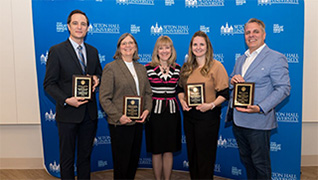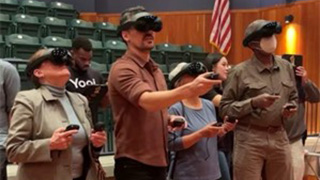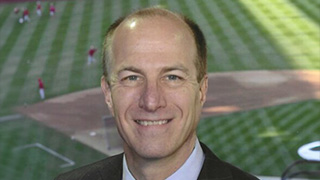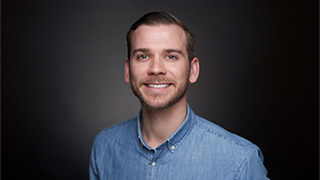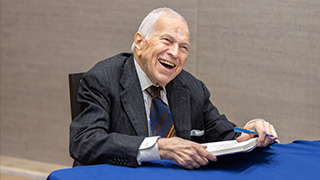NSF Students Compete in DHS Hackath
Monday, April 17, 2023
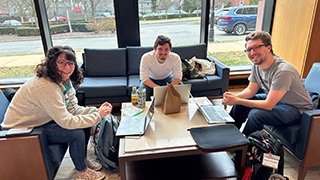
Christina Grossen, Peter Roberto, Brent Findon collaborating on project.
Five members of the National Security Fellowship (NSF) had the opportunity to expand their experiential learning during the last weekend
in February by participating in Arizona State University’s Devils Invent and Designing
Actionable Solutions for a Secure Homeland (DASSH) hackathon to create a design to
divert domestic terrorist attacks. ASU partnered with the Department of Homeland Security
(DHS) for the event themed “Protecting America’s Public Access Areas.” Though the
team, composed of Brent Findon (M.A. ’23), Christina Grossen (M.A. ’23), Annelise
Preske (M.A. ’24), Peter Roberto (M.A. ’23), and Josh Smith (M.A. ’24), did not win,
they greatly enjoyed their time working on their recommendations and were asked to
conduct their project and submit it to the DHS Soft-Target Engineering to Neutralize
the Threat Reality (SENTRY) Center of Excellence.
Arizona State University is among a small group that hosts DHS Centers of Excellence.
These Centers develop multidisciplinary, customer-driven, science and technological
solutions that focus on shaping engineering-related outcomes. During the DASSH competition
this year, 115 students participated, representing 23 teams and 11 institutions across
the country, including the territory of Puerto Rico. Participants covered all ranges
of higher-level education and represented the fields of Computer Science, Engineering,
Cybersecurity, Homeland Security Studies, Environmental Sustainability, and our own
Diplomacy and International Relations. On the opening night of the competition, three
problem statements were presented, and each team chose one to focus on. The NSF team
created recommendations centered on “How do we guide crowds to make good decisions
during an attack?”
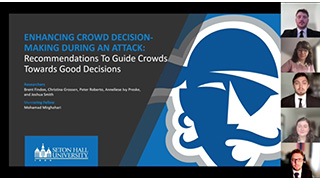
DASSH Presentation.
Over the three-day competition, the NSF students met in-person and on Zoom to work
through their problem statement. The DASSH competition provided opportunities to meet
with mentors, receive feedback, and further input into their projects. Students met
with SHU’s Tom and Ruth Sharkey Distinguished Mohamad Mirghahari, David Young, former senior advisor to the TSA Administrator, and SENTRY Center Director,
Michael Silevitch, Ph.D., Northeastern University Distinguished Professor of Engineering.
The mentors helped the students narrow down their focus and consolidate their information.
When discussing the merits of the program, Peter Roberto said, “competing in DASSH’s
hackathon was a new and exciting experience. It demonstrated the pressures that decision-makers
face when confronting a real problem set and allowed the team to collaborate with
each other.”
The team’s project, titled “Enhancing Crowd Decision-Making During an Attack,” took
a holistic approach and looked at ways to support citizens to make good decisions
pre-attack, during the attack, and post-attack. For pre-attack, the students recommended
expanding marketing for DHS-sponsored campaigns and increasing educational training
for local forces and citizens. During the attack, the team recommended implementing
a centralized framework, establishing call centers to alleviate the burden from 911
centers, and ensuring that police officers are clearly identifiable. Finally, post-attack,
DHS and local forces should create a system similar to AMBER Alerts and create a lesson-learned
assessment center. The students created a two-page memo and presented a 5-minute presentation
on Sunday afternoon.
According to Beth Jones, the Managing Director of the U.S. Department of Homeland
Security Center of Excellence (COE) Center for Accelerating Operational Efficiency
(CAOE) at ASU, said that none of the projects from the past six years have made it
from conception to implementation because the transition from academia to implementation
has a rather lengthy timeline. There is an opportunity for students to continue the
work on the projects after the competition, as “Dr. Silevitch and (Northeastern) team
will be presenting their concept … to the Under Secretary of DHS S&T on his scheduled
visit to their campus in early April.”
Seton Hall’s NSF team was asked to expand their project. At the request of Silevitch,
the students added more information about what a virtual command center would look
like and how it would operate on a given site. While the competition only lasted a
weekend, the relationship and connections will build, helping to provide more opportunities
for future students. We congratulate the team and their mentor for a good first showing
and look forward to seeing what else great minds can do!
Visit our website to learn more about the opportunities available through the National Security Fellowship.
Categories: Education

